Adam Gault
I often post updates regarding the S&P 500 “SPX” (SP500). My last report was published on May 27. Today, I maintain my conservative/intermediate and long-term bullish outlook for the SPX, especially for high quality “blue chip” stocks.
On The SPX had a rocky post-PCE session on Friday, falling around 2%, but recovering most of the losses late in the session. However, this year, “Sell in May and Leave” has not really been a profitable strategy, as the SPX has seen a considerable recovery after a slight pullback in April.
The million dollar question is whether the pullback/consolidation phase will end soon, paving the way for new highs, or whether the SPX and stocks will generally have more declines to come.
A crucial technical reversal
SPX (StockCharts.com | Advanced Financial Charts and Technical Analysis Tools)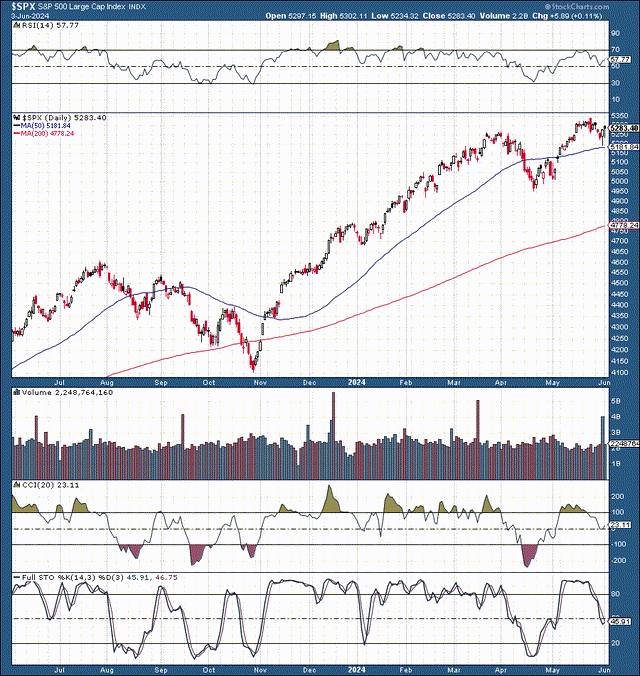
The SPX reversed around the critical support level at 5180-5200. This crucial zone coincides with the vital 50 day MA. Although the SPX may consolidate around the 5,300-5,200 range, the main average remains in a robust uptrend. The crucial support level remains at the 5,180-5,200 level, and the SPX would likely retest the 5,000 support zone if the 5,200 level breaks decisively.
On a positive note, resistance remains around 5,300-5,350, and the SPX may advance to 5,500 or more once initial resistance is breached, signaling a positive outlook for the index. Due to the combination of long-term fundamental and technical constructive variables, my year-end SPX target is in the 5,800-6,000 range.
Continued progress on inflation
Core PCE (Investing.com – Stock quotes and financial news)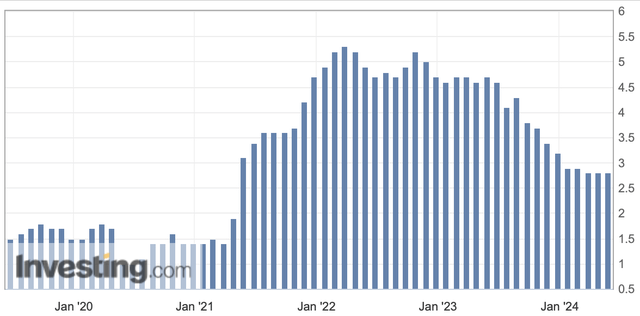
As expected, the recent core-PCE came in at 2.8%, better than last month’s higher-than-expected figure. This dynamic suggests that we have experienced a transient rise in inflation and may once again see continued progress. Additionally, we have seen a similar (higher than expected) increase in the CPI and other inflation indicators. However, the most recent CPI index was also better than expected, illustrating continued improvement in inflation from multiple sources.
What could be the real inflation?
Real-time inflation (Real-time independent, economic and financial data on-chain)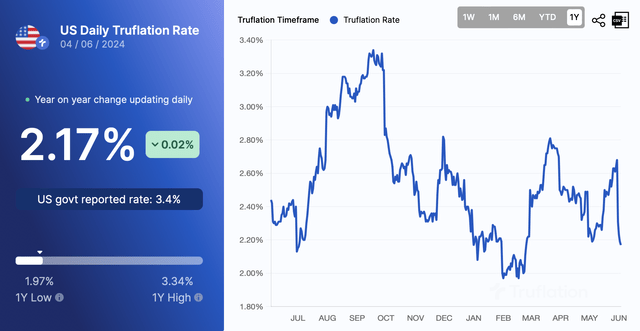
The actual inflation rate may be lower than what the CPI and PCE suggest. While the PCE and CPI lag government inflation indicators, truflation is more of a real-time (independent, non-governmental) inflation indicator. Truflation illustrates inflation around 2%, which is relatively low, right around the Fed’s 2% target range. This dynamic implies that CPI and PCE could fall into the 2% range and the Fed could soon begin cutting interest rates.
Rate Cut Probabilities Increase
Rate Probabilities (CMEGroup.com)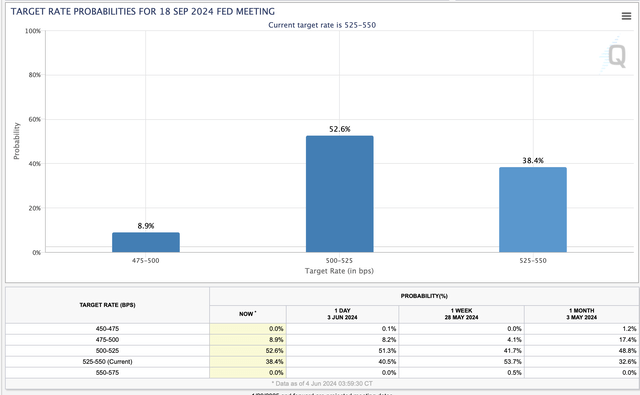
The chance of a rate cut at or before the September FOMC meeting is over 60%, considerably higher than the 45% seen a week ago. We’ve seen an increase in rate cut expectations since CPI, PCE and other crucial numbers were better than expected. The trend is moving in the right direction and the odds of a Fed rate cut should continue to increase as better-than-expected future economic numbers materialize. The next critical reading is Friday’s jobs report.
The Crucial Jobs Report
Payroll (Investing.com – Stock quotes and financial news)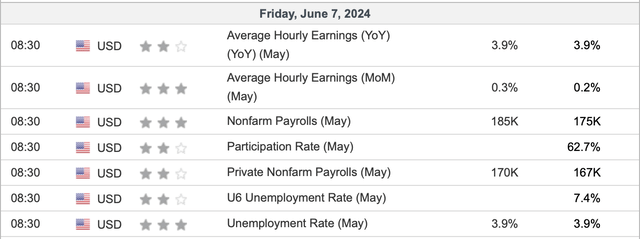
This Friday we will have a crucial jobs report that could influence rate probabilities and move markets. The expectation is 185,000, and last month’s reading was 175,000. The previous month’s results were constructive as they were slightly below expectations, and we are looking forward to another Goldilocks employment report .
The market is expected to respond favorably to a figure of 100-175,000 jobs, as this would illustrate a slight slowdown in the labor market, increasing expectations of lower rates while maintaining the image of a very resilient labor market.
We want to avoid a reading above 200-225K, which could decrease the chances of a rate cut. We also want to avoid an employment figure that is too low, as this could suggest a deterioration in the labor market, raising concerns about the increasing likelihood of a hard landing or recession to come.
Discuss Earnings Action
We recently experienced another very successful and productive earnings season, with many leading, high-quality companies beating earnings expectations and providing optimistic guidance for fiscal 2024 and beyond. Additionally, we see continued strength in AI-related stocks and other growth areas. We are also seeing rebounds in metals, alternative energy and other constructive areas, pointing to improved economic growth ahead. Even though most of the key results have already started, we look forward to the next results season and hope we see more great results.
Valuation Check – Is the S&P 500 expensive?
P/E Index (WSJ.com)
While the SPX’s TTM P/E ratio is around 23, its forward P/E ratio is around 21.5. This phenomenon suggests that we could see further SPX appreciation and P/E ratio expansion due to strong long-term growth prospects and a more accessible monetary environment in the coming years. Additionally, we have the Nasdaq 100 TTM’s P/E ratio around 31.4 and its forward P/E ratio around 27.4, implying considerable growth potential and prospects for outperformance. The forward P/E multiple of R2K is particularly low, around 25 here. This dynamic illustrates that small and mid-cap stocks could outperform in the future.
The essential – The rally can continue
The SPX (Presentation of ToS platforms)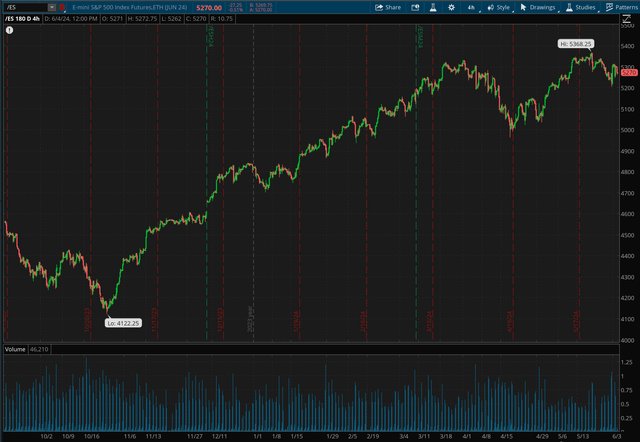
The SPX has come a long way from the bottom of the fall 2023 correction (30% trough to peak). Although we saw a slight pullback several weeks ago, we could see continued volatility and transitional turbulence. Furthermore, the SPX could retest the 5K level and, in the worst case scenario, could test lower support levels like the one around 4,800 if the 5,200 support level in the SPX collapses decisively.
Despite the potential for short-term turbulence, it is essential to remember that the SPX is still in a long-term uptrend. Several positive factors, such as progress on inflation, a resilient economy and potential interest rate cuts from the Federal Reserve, could propel high-quality stocks significantly higher in the coming years.
An improving growth climate, combined with a more accessible monetary environment, should enable high-quality companies to increase sales and improve profits. Additionally, many businesses are expected to benefit from the AI phenomenon (directly or indirectly), which should result in greater efficiency and profitability. As a result, stocks and other riskier assets could continue to appreciate, allowing the SPX to reach my target range of 5,800 to 6,000 by the end of the year.